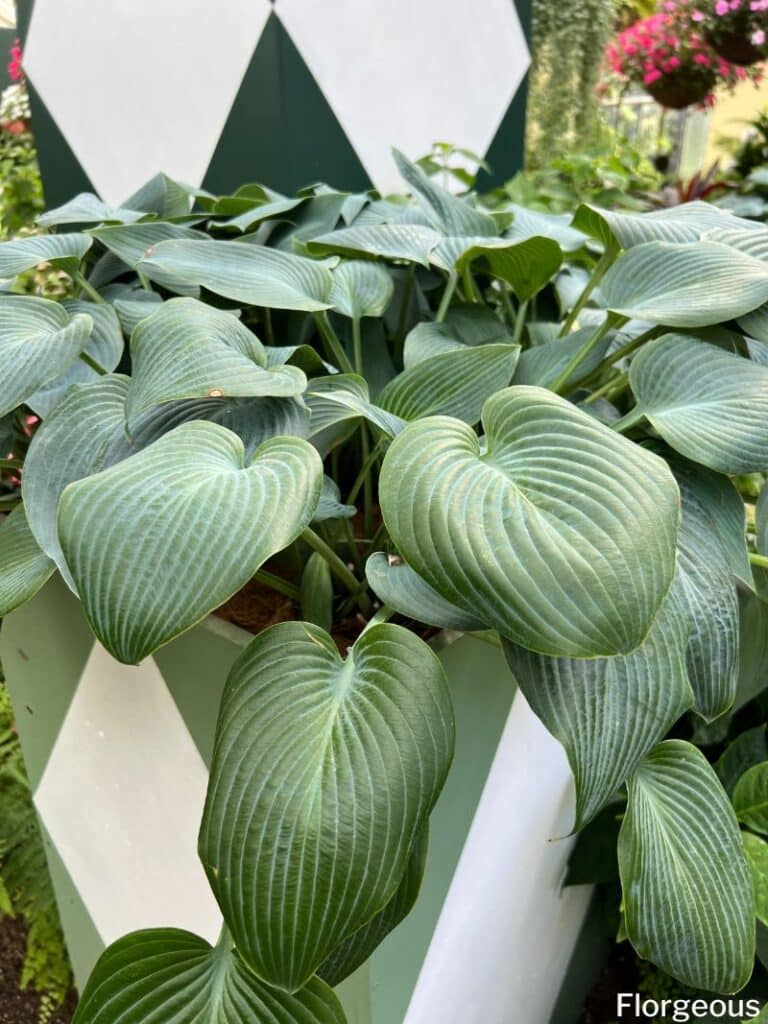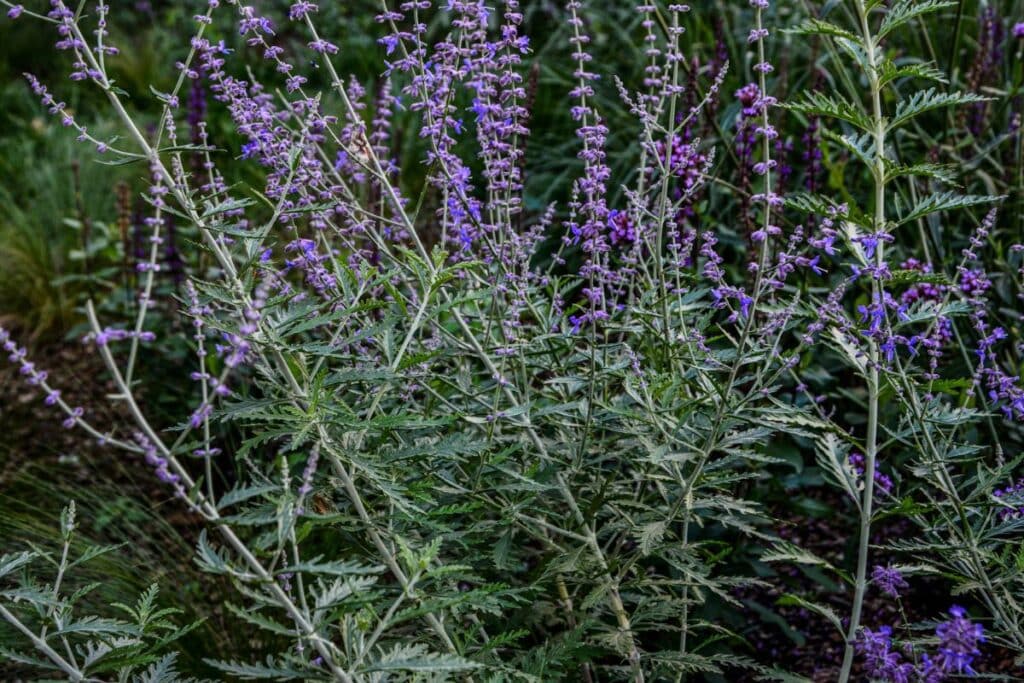Liriope (Liriope muscari) also known as big blue lilyturf, lily turf, border grass, and monkey grass, is a very beautiful perennial that produces grass-like foliage and beautiful purple flowers on tall spikes.
These ornamental grasses are often used as border plants, filler plants, and hedges and they can create a very charming look when grown in containers.
There are quite a few different species of liriope including a variety that is very low in stature called dwarf liriope (Liriope ‘Arizona’). The foliage of these different varieties can range from dark green to a sunny yellow-green color and some of these varieties have bi-colored foliage.
Most of these varieties produce beautiful purple flowers but some do create pink, blue, or even white flowers. In the fall, these ornamental plants will produce black berries that can also add lots of aesthetic charm.
Monkey grass can look very beautiful all on its own but to get the most out of this plant species, it is best to pair it with plants that complement the colors of these perennials.
In this guide, we are going to take a look at some of the best liriope companion plants that you can consider for an eye-catching garden.

What to Plant with Liriope?
Before you can start doing matchmaking by choosing plants that will look attractive alongside liriope, you should first consider the growing conditions of this ornamental grass.
Monkey grass is one of the most flexible plant varieties you can have in the garden. This is because it takes well to any type of soil and you can grow it in full sun or deep shade.
This grassy plant grows well in hot and humid subtropical locations and will produce lush foliage if you establish it in nutrient-rich soil that drains well.
The plant requires regular watering but they will survive in short periods of drought.
Let’s take a look at some other plants that will look attractive next to liriope.
Blue Fescue
Blue fescue (Festuca glauca) is a good option if you want to add more than one variety of ornamental grasses to your garden. This plant, along with liriope, is a good option if you want to add a thick ground cover underneath larger trees or if you want to create a mixed border for your garden beds.
Blue fescue will add lots of texture to your garden because it also has long spiky leaves that resemble grass. This plant with its silvery blue foliage will add lots of interest and color to your garden.
This ornamental grass thrives in full sun but it can survive in partial shade. In full sun, this cool season grass will produce light green flowers on tall spikes that turn golden brown over time. This display can add lots of texture to your garden bed.
Blue fescue prefers moist soil and it should be established in well-drained soil. As with monkey grass, it can also tolerate a wide range of conditions.
These attractive plants typically grow to a height and spread of 30 centimeters. As they spread, they will produce attractive grassy orbs.
You can grow dwarfed species of liriope in front of blue fescue or establish taller varieties behind this pale blue foliage. Since both are flexible in terms of watering and soil, they should grow well alongside one another in just about any type of garden bed.
Grape Hyacinths

The foliage of grape hyacinth plants (Muscari) can look very similar to liriope leaves but unlike liriope, this perennial bulb produces blue urn-shaped flowers that look a lot like grapes on a tall spike.
These plants are ideal companions that will grow well with liriope because it is helpful for filling out your garden bed and the attractive flowers will add contrast for an eye-catching look when it, and your monkey grass, blooms in spring.
Grape hyacinths need well-drained soil and can be established in full sun or shade. In a sunny spot, this plant will produce a lot more flowers but these blue flowers tend to last a lot longer in shady areas.
With a maximum height of 6 inches tall, these lilyturf companion plants are much shorter than most varieties of liriope. For this reason, it is better to establish them in a row in front of the other plants in your garden.
Hard Ferns
Hard ferns (Blechnum spicant), also known as deer fern, are another great option if you love foliage gardens with lots of texture. The hard ferns will create a beautiful backdrop for your liriope plants and will help the purple flowers stand out even more when they appear from spring to late summer.
Hard ferns will flourish in well-drained soil that is kept moist but these tough plants can survive spells of drought. They can grow in full sun but are also happy to grow in the shade where you plant liriope.
These low-maintenance plants along with your liriope will create a living mulch that can keep the soil moist and they will act as organic fertilizers to nourish other plants like trees in your garden.
Deer fern can grow up to 60 centimeters tall and it is best to pair it with variegated liriope so you can add more contrast and color to your garden.
Because variegated liriope is a bit shorter with a maximum height of 35 centimeters, it is usually best to establish the ferns in the back.
Hostas

Hostas (Hosta), also referred to as plantain lilies, are very popular in shade gardens and are ideal plants to pair with liriope plants if you want to add more texture to your garden bed.
Hostas are mostly grown for their beautiful foliage. The plant produces dense growths of leaves that can create a thick ground cover.
Hostas do produce white and cream blossoms but these flowers are not nearly as notable as the vivid colors of some mixed foliage varieties.
Hostas can grow very well in any soil type but they do need frequent watering and prefer moist soil. These plants grow well in full to dappled shade which makes them perfect companion plants for liriope.
You can grow any variety of liriope next to hostas since none of these plants are not too fussy about their environment. Many gardeners do however prefer to pair blue lilyturf with hostas for a more striking effect.
See more: What pairs well with hosta plants
Russian Sage

Russian sage (Salvia yangi) is a popular plant variety to add to rock gardens and can look stunning if paired with liriope.
The grassy look of liriope will add lots of texture to your garden and sage’s purple flowers will complement the cool flower tones of liriope blooms very well.
This member of the mint family doesn’t need as much water as liriope but it can grow well in well-draining soil.
Sage needs a lot of direct sun to flower but because it is much taller, it will produce lots of shade to shield lower-growing plants like liriope spicata.
When companion planting, you should establish sage in the back because it can grow quite tall with a maximum height of 5 feet. Establish variegated cultivars of liriope around the base of your sage to fill out the flower beds.
With this type of pairing, both plants can grow healthy and they will add lots of color when the two plants start to bloom.
Related: What looks good next to Russian sage?
What NOT to Plant with Liriope
Because of liriope’s flexible nature, it can survive next to just about any plant variety but some plant species can be affected by liriope.
Here is a quick look at some bad companion plants that shouldn’t be grown next to liriope.
Slow Growing Plants
Monkey grass is a vigorously growing plant that can easily take over your entire garden. This perennial also has a tendency to smother other slow-growing plant varieties you might have.
It is best not to add slow-growing varieties like anthuriums, ZZ plants, snake plants, and succulents next to the liriope plant because the liriope plant can overpower these slow growers.
Drought Resistant Plants
Liriope can be a little bit drought resistant but it will die if it doesn’t get enough water. It is best to pair liriope with companion plants that also need regular watering.
If you grow it next to drought-tolerant plant varieties like lavender or black-eyed susans, you will create a scenario where either your liriope plants suffer because of the drought or the other plants start to experience root developmental issues.
Final Thoughts
Liriope is a remarkably flexible plant that can grow in any soil and in any lighting condition. As long as the soil is kept moist, this hardy plant will survive.
There are not too many companion plants that have these same growing conditions but because of their flexible nature, you can easily add liriope next to a huge variety of plant species.
Liriope grows very well in the same garden bed as hostas, Russian sage, hard ferns, grape hyacinths, blue fescue, and just about any other fast-growing plant that flourishes in moist conditions.
We hope that this landscaping liriope companion plants guide made it easier for you to find some good neighboring plants to add to your flower bed.
If you are looking for more tips on how to keep the other plants in your garden healthy and beautiful then we welcome you to have a look at some of our other guides.
See more:
*image by Wirestock/depositphotos







